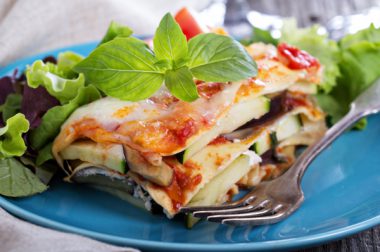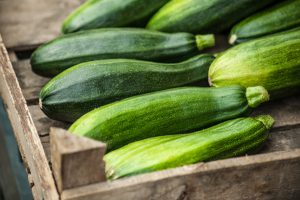Recipes we love
See all recipesCorn flakes with carrots and zucchini
An original recipe that invites the vegetables at the aperitif! A dish full of vitamins (beta-carote...
Farfalle pasta with sautéed zucchini and lemon
A tasty and tangy zucchini dish with lemon sauce that will satisfy the taste buds of young and old a...
Gratin of cauliflower and zucchini
A light but full of flavour recipe, ideal for evening meals. This dish provides vitamin B9 which hel...
Health
benefits
A feast for the eyes!
Zucchini is rich in lutein and zeaxanthin, which help to protect the retina.
Zucchini is also:
- A source of vitamin B9 (cell renewal, which is very important for pregnant women for the development of the fetus, growing children, and people recovering from illness).
- A source of vitamin C (the immune system, collagen formation, energy, the nervous system, fatigue, iron absorption)
Zucchini also contains:
- Potassium
- strong>Sodium
Equal amounts of potassium and sodium give zucchini naturally diuretic properties.
Nutritional
composition
When is the right time to eat it?
In the summer.
Zucchini is THE summer vegetable, in season from May to September.
Vegetable patch
or urban balcony?
Zucchini is an annual plant that grows well in humus-rich, well drained, light, and neutral soil (pH = 7), with a lot of sun exposure.
To learn everything you need to know about growing, read the page on growing advice.
Choosing
and storing
Choosing the best zucchini:
- They should be firm, have no marks, and preferably be small (large zucchini has less flavor because they contain more water).
Storing zucchini:
Zucchini is a fragile vegetable that should be eaten shortly after buying.
- In the refrigerator: Four to five days in the vegetable drawer. Wash preferably right before cooking.
- In the freezer: Dice and blanch. Place in freezer bags and keep for a maximum of eight months.
Tips
and tricks
How to prepare zucchini:
Nothing’s easier to cook than zucchini! There’s no need to peel (the skin contains many nutrients), especially young zucchini.
Tip for conserving the nutrients in zucchini: Don’t cook for too long, sauté or steam. This will preserve its antioxidant compounds. Or even better, eat them raw!
Cooking instructions:
- 1 or 2 mins: In boiling water with the lid off for ‘al dente’ zucchini
- 3 or 4 mins: Steaming
- 5 mins: In a microwave oven
- 10 mins: Fried or on the barbecue
- 20 mins: In the oven
Anti-waste tip: Zucchini flowers are also edible and can be prepared in many ways, for example, battered and deep fried, in an omelet, or stuffed with fromage frais.
La courgette se marie avec…
Crue. Et oui, la courgette se consomme crue aussi! Un peu comme le concombre. En ingrédient des salades composées avec tous les autres légumes d’été.
Cuite. Elle s’accompagne toujours des légumes d’été (tomate, poivron, aubergine, ail) et en version cuite, c’est la fameuse ratatouille.
Elle fait aussi très bon ménage avec les épices, les herbes, les viandes blanches et les poissons (le curry, la volaille, l’agneau, le basilic, les herbes de Provence, l’ail, etc.) mais aussi les fromages (le parmesan, le chèvre, le brebis), les oeufs. Elle peut être la base de sauces pour les pâtes.
Dans un potage, elle remplace les pommes de terre pour leur liant.
Et dans un gâteau au chocolat, la courgette peut remplacer une bonne partie de la matière grasse, tout en apportant du fondant. Surprise garantie!
Astuce anti-gras. Farinez les courgettes avant de les poêler. Elles absorberont moins de graisse et seront plus croquantes. Assaisonnez-les en fin de cuisson, pour une meilleure tenue.
Can everyone eat it?

Young children
Babies love the delicate flavor of zucchini and can eat the vegetable from the age of six months in a purée by itself or mixed with mashed potatoes. If older children won’t eat them, mix them into lasagna, pasta sauce, or pizza, for example.
And everyone else
Zucchini is easy to digest and suitable for everyone. They’re simple and quick to prepare, which makes them ideal for everyday use in the summer.
See plenty of other tips for encouraging children to eat vegetables
Where do they come from?
Origins and varieties
Origins
In Europe, Italy is one of the biggest zucchini producers, followed by Spain and then France. In the winter, Morocco produces a large quantity of zucchini.
Zucchini is an important part of traditional cultures in the US, and have been eaten in Mexico since 7,000 BCE.
Varieties
Different types of zucchini come in different shapes (the classic long zucchini, round zucchini that can be stuffed, mini-zucchini, which are very popular in the south of France), and also in different colors, like dark green (known as ‘black’ zucchini), pale green (known as ‘grey’ zucchini), and yellow.



 Bean sprouts
Bean sprouts  Eggplant
Eggplant  Vegetable garden: growing eggplant
Vegetable garden: growing eggplant 










